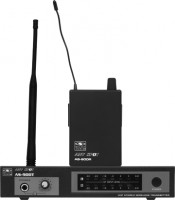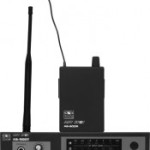Get the Perfect Stage Mix Every Time
The worst experience a singer can ever have is playing a live show in front of hundreds or thousands of people and not being able to hear their vocals. Even drummers can have a hard time staying on a steady beat without a metronome blasting in their ears. In-ear monitors have become an essential tool to help create a flawless performance for the fans. With so many choices available in your local music shop, it can be hard to pick out the right one for your specific needs. Since relying on venue floor monitors can sometimes lead to disaster and cranky musicians, what type of in-ear monitors are right for the average musician?
When shopping for in-ear monitors, a musician has to consider important features that may impact their pocket, but in the end will provide a quality product built for longevity. Range, inputs, volume output, comfort, and battery life are all among the features that need to be considered. Common models at local retailers may seem just what a singer may need, but in reality may be better suited for a drummer or guitarist.
 Galaxy Audio AS-900 Wireless Personal Monitor System
Galaxy Audio AS-900 Wireless Personal Monitor System
Frequencies are very important in in-ear monitors. These systems usually run on UHF channels (yes like the ones on televisions). While most in-ear monitors allow you to scan to find the best channel to avoid static from interfering frequencies, the Galaxy Audio AS-900 only provides one frequency. The possibility of scanning for a clear sound if the user experiences static is impossible. This helps the system stay at a lower price point for those who want a basic in-ear system. The user may also want to utilize this system in a smaller venue as the range between the body pack and the system itself is between 100-150 feet. Two AA batteries will do the trick for the pack for about five hours, of course that is depending on how loud the volume is during usage. At louder levels not only is more battery life consumed, but distortion may be heard from peaking due to the fact that this device does not have a limiter. Like most monitor systems this is an XLR and ¼” input combo. This product is great for entry-level musicians playing smaller gigs or for a drummer who just needs to hear a basic click track. Galaxy also offers the next step up, the AS-1100, for those musicians who wish to have a variety of channels to choose from to avoid frequency interference.
 Nady PEM – 500 Wireless Personal Monitor System
Nady PEM – 500 Wireless Personal Monitor System
This level of the Nady product is hard to come by at retail stores, but still available. This is an inexpensive product that can be used as a click track or vocal monitor. Guitar frequencies become a little more jumbled as the mix becomes more complex, but the unit can be switched to a stereo or mono signal, which is nice. The system has a limiter, which is very important because it prevents horrible distortion that can occur at high volumes. The range between the body pack and the system can be up to 300 feet assuming the system is not behind a concrete isolated sound booth. There are 16 different UHF channels to choose from which makes it very reliable in mostly any setting. This model has XLR and ¼” inputs, as well as a headphone output in the front. The body pack lets you know when the six hours of battery life are almost drained with an LED indicator. When the pack blinks red, have a 9V handy. The only downside to this system is the pair of uncomfortable ear buds it comes with. The casing to enclose the system is great, but if mishandled can crack at the hinges which can cause unwanted damage to a dropped monitor system! Not to worry though, Nady is known for having a receptive customer service department that can help replace or repair damaged product with a fast turn around.
 Audio Technica M2 Wireless Personal Monitor System
Audio Technica M2 Wireless Personal Monitor System
With 100 selectable UHF channels, it is nearly impossible to ever have a frequency interference problem with this monitor system. The body pack is light like its competitors but offers more comfortable and durable ear buds. With eight hours of battery life on two AA batteries, it is not hard to see why this model starts at a higher price point. This is perfect for the gigging musician. With three different types of settings for stereo, mono, and mix, this is ideal even for the guitarist who wants to keep up accurately with the drummer without getting his or her hearing drowned out by blaring symbols and vocals. This is also great for musicians who use backing tracks and would like to individually listen to them while jamming to make sure they keep in time. A drummer can easily hook up his own laptop with a click track program or metronome with the 3.5mm line in input. The best feature is that several body packs can receive the same signal with individual body pack option of stereo, mono, or mix.
 AKG IVM 4 Wireless Personal Monitor System
AKG IVM 4 Wireless Personal Monitor System
With this wireless system, you get what you pay for. For the high price point, this is for the serious musician. With 1200 frequencies to choose from, and a preprogrammed bank, this is just the beginning of what this monitor has to offer. This beautiful system has an EQ, limiter, automatic frequency environment scan, high isolation ear buds, and the best part – up to 10 hours of battery life on the body pack! Large or small venue, it does not matter when it comes to this model, a crystal clear signal is guaranteed even when dealing with other complex signals in the area. The only downside is the bulky antenna that can easily get tangled in clothing, or get uncomfortable while performing. The antenna issue is well worth getting over when you have a product this powerful. This one may need to be special ordered at some retailers.
 Sennheiser EW300 IEM G3 Wireless In-Ear Monitor System
Sennheiser EW300 IEM G3 Wireless In-Ear Monitor System
From the company that brings you world-class microphones and headphones comes the EW300 G3 series in-ear monitor. Much like the AKG model, what sets this in-ear monitor system apart from the competition is the availability to remotely control the system from a computer. Unless a musician is playing a major venue, or has an extremely high tech sound engineer, this function may not prove useful for your needs. On a professional level though, it can become very advantageous as now a complete and accurate mix can be delivered to all parties with body packs linked to the system. The receiver has a 5-band equalizer, HDX Compander for a crisp sound, 1680 frequencies, and a variety of pricey accessories to add on to the system. The accessories range from rechargeable batteries to signal boosters. The same bulky antenna issue as the AKG is applicable to this device.
Parting Thoughts
Depending on the level of quality, these devices start at $200 and go up into the $1000 price range. From personal experience with these in-ear monitors as a musician myself, and trying them out at the prestigious NAMM convention in California, I can assure any musician that the need to spend $500+ on an in-ear monitor system should be considered only if you are a seriously touring and gigging on a regular basis. A drummer may want to stick to a Nady in-ear monitor system, as it provides flawless sound, even with backing tracks running through them. A guitarist may want to consider an Audio Technica only if floor monitors are not feasible, and the same goes for any other instrumentalists. Both Audio Technica and Sennheiser in-ear monitors are great for vocalists because they provide impeccable accuracy when it comes to sound. What a vocalist may want to consider is getting better ear buds, as most of the buds provided with the systems are very uncomfortable. Molded ear buds should be considered from non-retail store brand, Ultimate Ears – another pricey but high quality in-ear monitor company.
So next time you go to your local music shop in search of in-ear monitors, keep in mind the basics. What is the level of the project and what type of artist are you in terms of professionalism, touring, etc.? Remember the better the quality of the product, the higher the price. Compare and research the features and see what better suits your individual needs. When it comes to in-ear monitors, your perception of clarity is the key!

